
It's time to MASTER Colour Mixing and transform your paintings!
The Colour Mixing Detective
Stop mixing MUD and solve the mystery of your paints once and for all.
This is a Toronto technical painting course. IMPORTANT NOTE: This course is now offered exclusively ONLINE. Click here for full info on the ONLINE course.
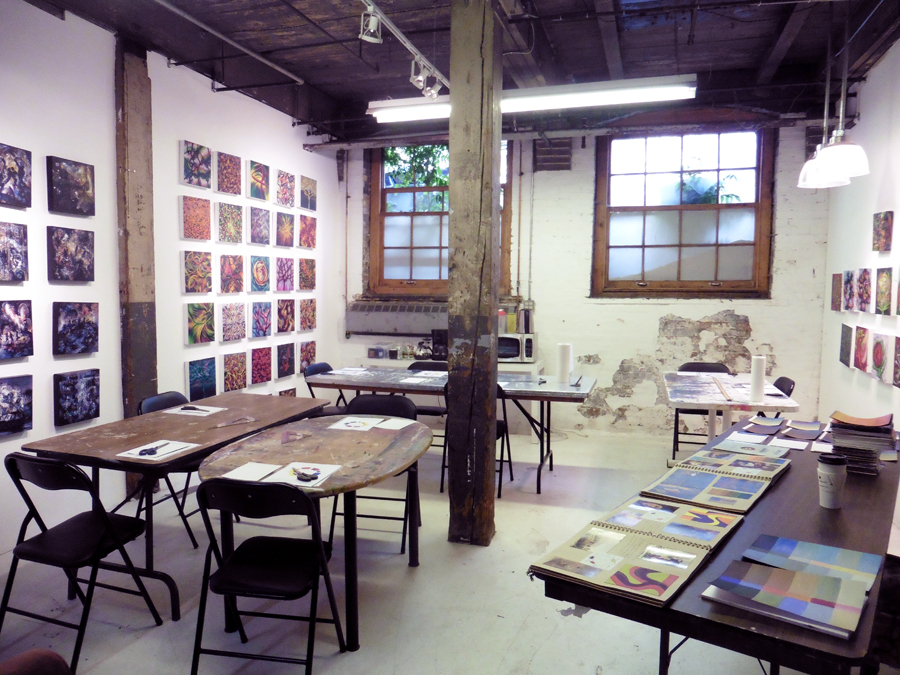
My studio at 401 Richmond St. West is the location for this course.
Are you constantly mixing MUD instead of the colours you want?
Have you ever mixed a great colour that felt accidental? And then you had no idea how to recreate it...
Are you wasting expensive paint and washing money down the drain?
Do your paintings look unsophisticated because you use paint straight out of the tube and boring obvious colours?
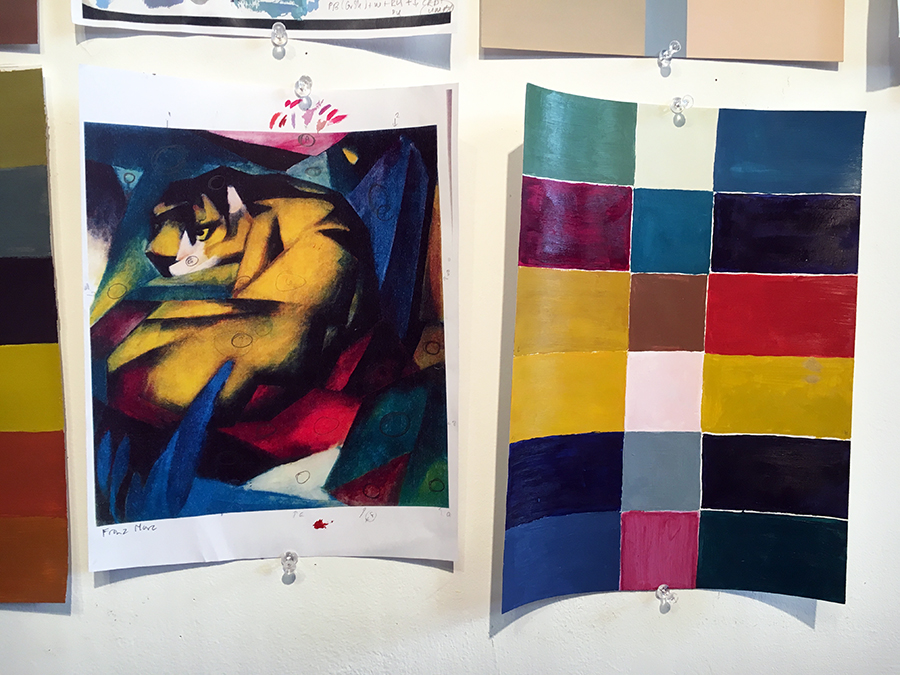
Simone Desilet's colour chart for Class 3: Yellow Day of Franz Marc's painting.
Ever wondered if there's some secret to colour mixing that no one has told you? Someone must know something.
Do you repeat the same colour palette on every painting because you're intimidated by your paints or scared to experiment with new colours?
Have you been frustrated by a previous colour "theory" course with zero practical value?
Or does your career in film/theatre/interior design require you to have a nuanced understanding of colour?
If you answered yes to most of these. You're in the right place.
“Before taking the course I wasn’t confident. All I knew was the basic primaries and secondaries. I was frustrated by not being able to create what I wanted to see. I wanted sophistication in my work and colours that didn’t look obvious. I wanted colours that were special. I wasn’t confident to mix them, so I would just buy them. I was concerned that the class would be hard and it would show my limitations.
Now my sensory perception of colour is heightened. Everything is so vivid. I’m able to see beyond what my mind initially thinks is there and push past that first thought. What’s really making that colour? It’s like thinking critically.
I really liked that it was structured as a demonstration and then the practical part. The majority of the time was us actually creating and doing the work. I loved the art history assignments in class. I liked that you were always coming by and checking in to give advice and walking us through the process. You gave us the ability to figure it out ourselves. I would definitely recommend the course.” - Natalie Lowe
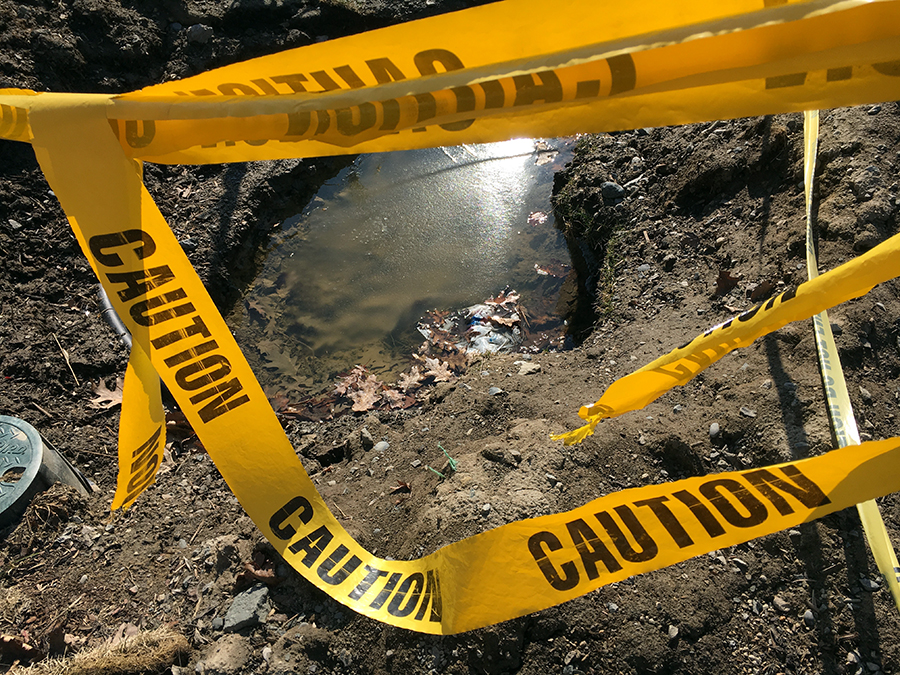
Careful! This is a crime scene!
There's been a murder and it's YOUR PAINTING!
Sometimes painting can be more dangerous than Midsummer County. Sadly bad things happen to good paintings. You were working away and then suddenly it all turned into an awful mess. What happened? Who's the villain of this story? Well in my experience it's almost always the obvious person - MUD!
But you're about to lay down the law when you become... The Colour Mixing Detective.
Ok, let's solve this mystery.
Welcome to your first case Sargent! We have an investigation to get to so it's time to put those little gray cells to work. It doesn't matter if your paintings are realistic or abstract, landscapes or portraits every one who paints needs to know how to properly mix their colours. Mixing beautiful sophisticated colours will take your paintings to a whole new level. Understanding paint makes you a better painter.
Learning colour mixing is like doing scales on a piano. It’s not the creative part like performing the song in a concert, but it’s all part of the process of learning and practice. What most people do is avoid ever addressing this problem. They don’t want to do the work.
To understand paint you need to understand it's nature.
I want colour mixing to become effortless for you so you don’t have to waste any more time worrying about that stuff. It's time to end the frustration. This is a course you do once and then never have to think about how to mix your colours again. This is a totally learnable skill. You'll gain a deep understanding and then be free to pursue the real work of finding your artistic vision.Making art is about so much more than mixing colours.
"I would say, if you want to really understand colour mixing and want a deep structure and understanding take the course."
- Alison Fleming
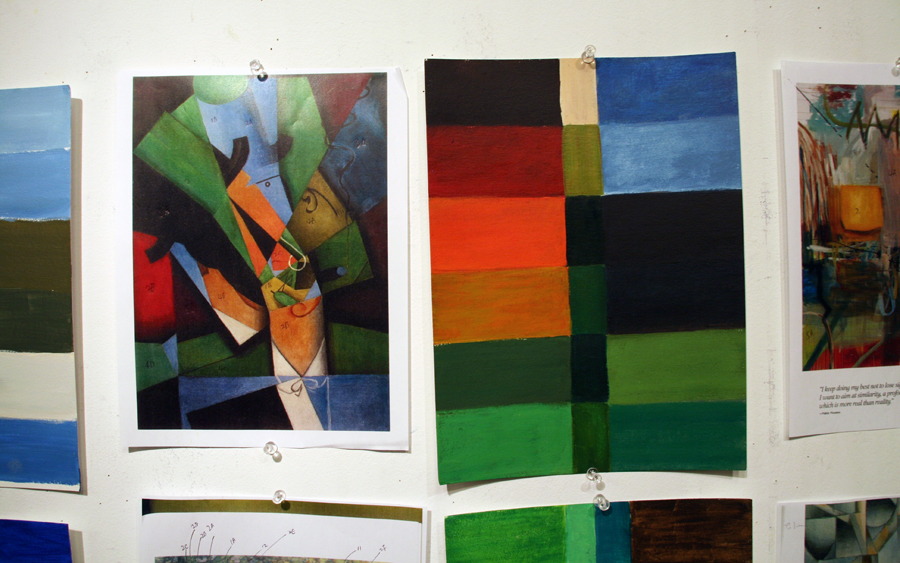
This is the course I would love to have had as a student.
It's one of a kind and far better than anything I learned in my 6 years in art school regarding colour mixing. I've built it over the last three years.
I can totally relate to your frustration with colour mixing. The problem isn’t you. It’s the way colour mixing is taught. Oh pardon me, I should say ISN’T taught. I had the same feelings when I was a student. I got around this by doing every colour mixing exercise in multiple books. Luckily for you I’ve created a course that doesn’t require you to spend this ridiculous amount of energy. In fact doing the prep for this course has significantly improved my colour mixing.
There comes a point in your artistic practice where you have to just do the work that needs to be done. Consider this course as a chance to learn what you need so you can finally move forward in your work.
It's time to take yourself seriously as an artist.
“Before I took the course I had some idea of the differences between reds, blues and yellows, but I really couldn’t have looked at a colour and been able to know how I’d even begin to mix it. Now I feel like I can do that. My biggest frustrations would be getting to a colour that I didn’t really want, and not being able to fix it. Sometimes I would add more colour and it would just get worse.
Taking the time to do the exercises in class and the homework colour charts was invaluable. Once I got started I found it was a lot easier to do it. Doing the homework is essential. I’m interested now in using new colours in my paintings. I might not have ventured into a different palette had I not taken this course. I really liked that it got more complex as we worked through it. It was structured really well. You have an ability to see where people are at and offer individualized feedback. I found the instruction very good. You had a good overall sense of how to present to a group and work with people individually.
Now when I’m looking at a painting in an art gallery I’m much more interested in the colours they use and how they mixed them. I spend longer looking at a painting now to try to appreciate the colours. There’s a lot going on in them. Far more than you might think. I wouldn’t have done that before. I wouldn’t have had that perspective. ” - Catherine Turl.
My other course Colour Stories and Relationships is all about achieving harmonious colour relationships. Like a Jane Austen novel, you’ll be scheming to find the perfect match. In Colour Stories and Relationships we'll be working on real paintings. We'll be trying out different colour schemes in your work and seeing what works for you. I want to give you a deep understanding of colour relationships so you can solve the problems that come up in your paintings. I'd suggest reading over both pages to decide which course is better for you. This course is probably the best starting point.
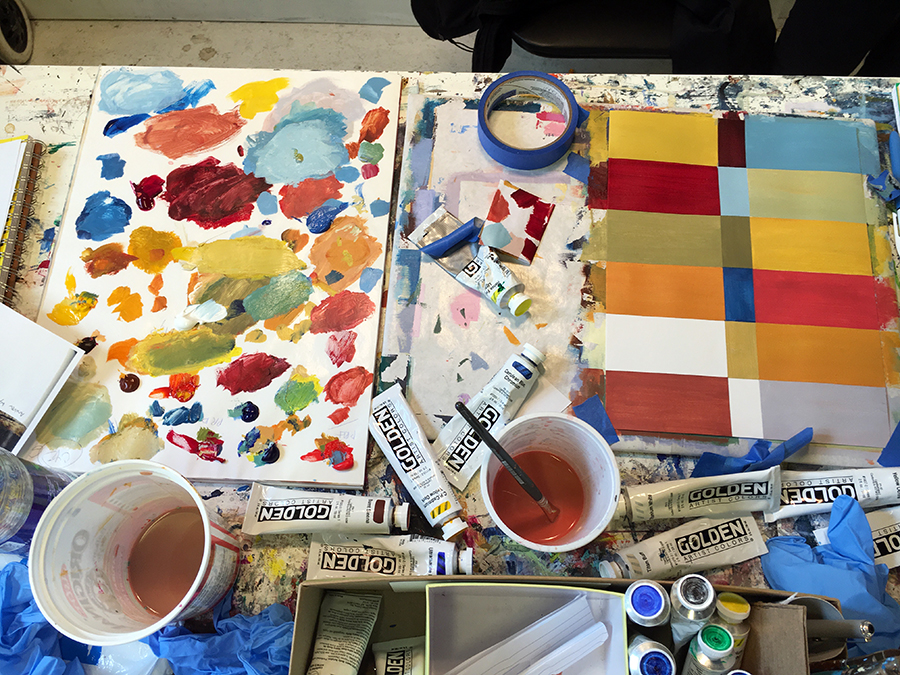
Class 4: Diana Hamer's studio mess on Orange Day.

Class 6: Here's Simone Diselet's chart from Purple Day.
Here's How the Class Works
I created Art School Untangled to teach one of a kind courses that you can't find anywhere else. These courses get right to the heart of problems students face and focus intensely on a single issue. They're about putting in a lot of work over a relatively short period of time so that you can save YEARS of struggle. There's a lot to learn in painting and drawing but it doesn't need to take you decades if you learn it right from the start.
Important Note: I strongly advise students to do this course BEFORE doing my other technical classes like Brushstrokes and Painting Effects. There is no escaping colour mixing. It's fundamental to painting. You need to understand your paints.
Homework
LINEUP CHARTS: I've invented a comprehensive system of colour charts. They're pretty amazing. You’ll see best results in class if you complete some of the Lineup Charts that I assign each week. They allow you to see a huge range of colour mixes on one page. Before the Blue class if you complete the Blue Lineups you’ll be ahead of the game as you’ll already be familiar with the colours. Working on this at home is the best option because you can go at your own pace. Students have described doing these as like a mindfullness meditation. Seriously, get ready to mix a ton of colour charts! You can complete as many as you can. You should be prepared to put in at least 2 hours of homework a week for this course. If you put in more you'll do even better. Some students think the charts are the best part of the course.
In Class Work
DEMONSTRATION: You'll be in a small class of 8 people max. When you arrive you’ll choose an image from around twenty art history images which relate to our weekly colour theme such as Earth Tones, Blue, Red etc. I begin with a demonstration where I show the nature of each colour group. We'll discuss the differences as group and try to figure out how to talk about them. It's quite challenging as we don't have the vocabulary to describe this kind of nuance.
ART HISTORY FORENSICS: Put on your Hazmat suit. Your class work will involve creating a chart where you try to mix all the colours you see in the painting. Most will be the weekly theme colour but not all of them. This will give you lots of experience trying to mix all sorts of different colours. Essentially you fixate on every nuance of the colour. We'll keep detailed notes on the mixes. Throughout the class I move around the room helping you individually and giving tips on how to go about mixing those colours with personal demonstrations. Students have described this course as like CSI. Kind of like doing an autopsy of a painting.
Colour Themes
Prologue: Welcome to the Case / My Colour Wheel (Pre-Class)
Chapter 1: Six feet under the EARTH TONES
Chapter 2: The Boys in BLUE
Chapter 3: Just a RED herring
Chapter 4: YELLOW caution tape
Chapter 5: Murder on the ORANGE Express
Chapter 6: A VIOLET End
Chapter 7: Death on the GREEN
Chapter 8: COMPLEMENT Case Files
Chapter 9: Little GRAY cells
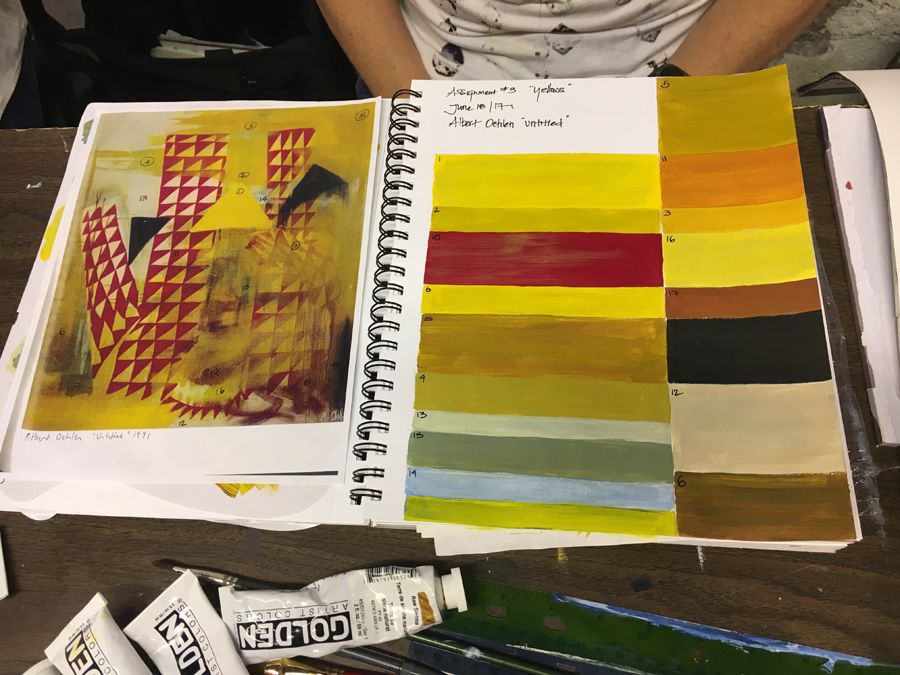
Class 3: Ingrid Anderson's chart from Yellow Day.
Change your perception as you learn from the great artists of art history.
You'll start seeing how beautiful and sophisticated the colours are in famous paintings. Matching the colours in art history images can become quite captivating. Students get obsessed with the nuance of colours. You'll be mixing colours you've never thought of. You'll be training your eyes to see a huge level of nuance. Students have described suddenly seeing colour everywhere they go differently. You might find yourself walking around Toronto trying to decipher how to make that colour out on the street!You'll build a life long reference guide. When you're finished you'll pull them all together into a beautiful portfolio you can refer to for years to come. When I was a student I created a colour book and I've kept it for 16 years. I love looking at it!
The emphasis won't be on theories of colour but rather on the practical task of how to actually mix pigments properly. Sometimes the results are surprising and unpredictable.
Let's be clear - this course requires discipline. It's a lot of work.
You need to arrive with the right mindset. It is not about doing creative paintings and expressing yourself. This is about doing the hard stuff that most people never bother to do. You'll be taking your paintings to the next level.
"During the abstract painting class Gareth brought in his colour mixing book. It was and is very intriguing and beautiful. What got me excited was the process involved in creating a book like that. And the fact that I wanted to learn about colours & how to make colours." - Romana Huq

Class 3: Here's Ingrid Anderson's chart from Red Day

Shyamala Millar's colour chart for Class 6: Purple Day. Later in the course when she had more confidence she started to immitate the effects in this painting by Varley. This took the chart to a whole other level.
Art Untangled
The Colour Mixing Detective
Solve the mystery of your paints once and for all!
DETAILS
Spring Registration: OPEN
Instructor: Gareth Bate
City: Toronto, Ontario, Canada
Class Location: My studio at 401 Richmond St. West, Studio S-17 in the Basement orange section. (At Richmond & Spadina.) See Google Map.
Number of students per class: 8 maximum
Spots Remaining Wednesday Afternoon: 5Duration: Nine Weeks
Price and Registration Info at the bottom of this page:
Important Note: You must be able to attend the first class. It's essential. You must also complete the pre-class assignments before the course starts.
Registration Deadline: March. 20, 2020
Your painting supplies are not included - see full list below.
Spring 2020 Wednesday Afternoons:
2:00 pm - 5:00 pm
5 Spots Available
Week 1 - Earth Tones Wed. Apr. 1, 2020 Week 2 - Blues: Wed. Apr. 8, 2020 Week 3 - Reds: Wed. Apr. 15, 2020 Week 4 - Yellows: Wed. Apr. 22, 2020 Week 5 - Oranges: Wed. Apr. 29, 2020 * Free Bonus Makeup Class: SUNDAY. May 3, 2020 Week 6 - Purples: Wed. May. 6, 2020 Week 7 - Greens: Wed. May 13, 2019 from 10 am to 1 pm Week 8 - Complements: Wed. May 20, 2020 Week 9 - Coloured Neutrals: Wed. May 27, 2020 - LAST CLASS! PARTY TIME!
Important Note: This course will not return again until Winter 2021. So now is the time to do it!
Dates don't work for you?
If you're interested in this course but these dates don't work for you be sure to subscribe to my newsletter so you get updates from me about future courses. I change the days and times each semester. My evening classes and Saturday classes happen in Spring. Shoot me an email to let me know that you're interested. contact@garethbate.com
SPECIAL OFFER:
You can SAVE $50 off your course price if you sign up a friend who hasn't taken my courses in the past. I take $50 off for each person you sign up.
Need to miss a class?
No problem, I got you covered!
I'm offering one FREE BONUS Sunday morning makeup class. See dates above.
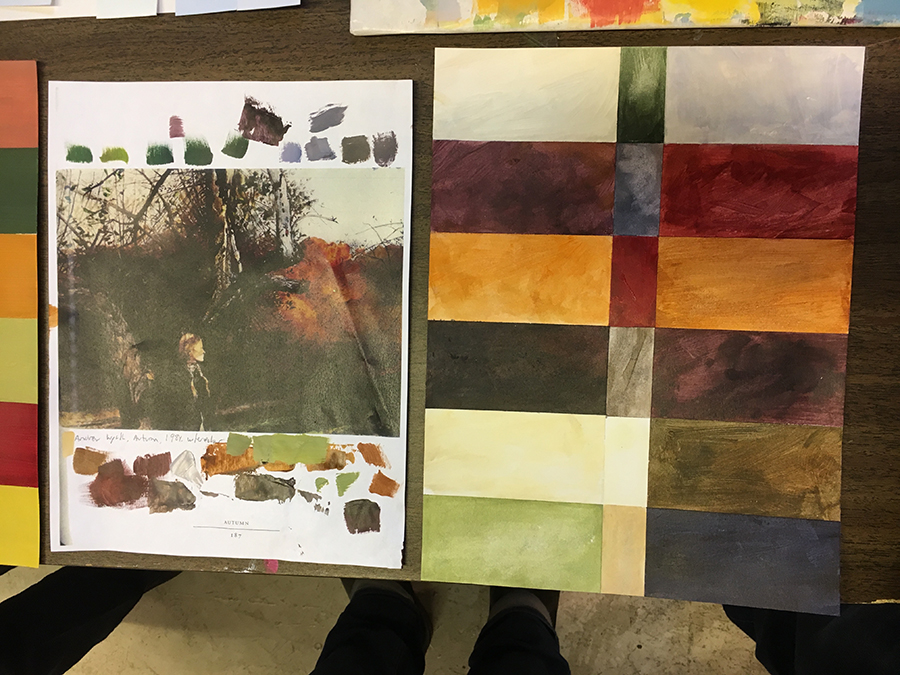
Class 7: Diana Hamer's Earth Day colour chart of Andrew Wyeth's painting.
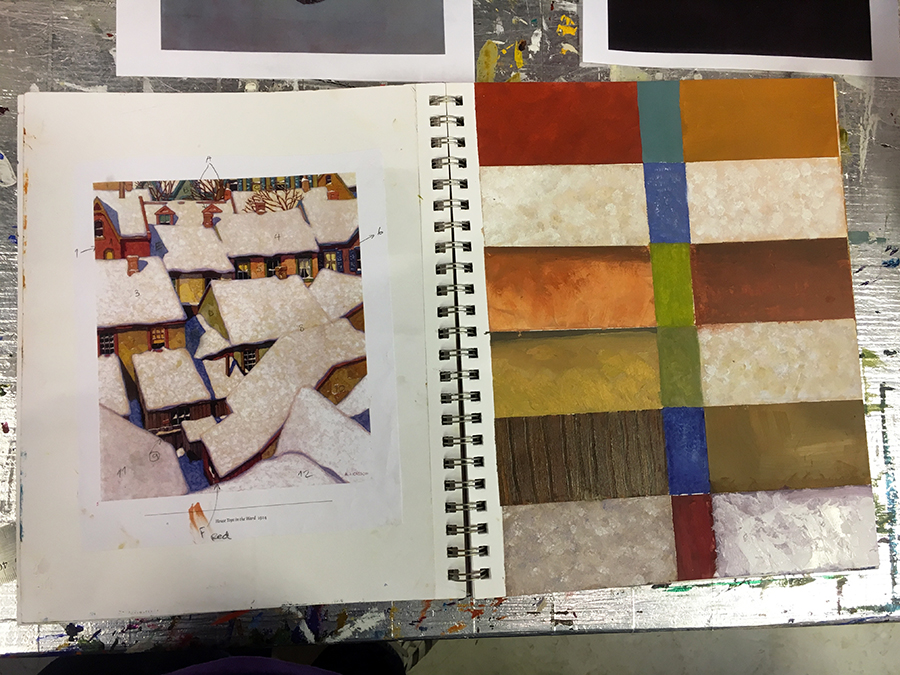
David Barron's colour chart for class 7: Earth Tones. David started to change it up by actually painting the textures that appear in the painting by A.J. Casson.
Course FAQ
I did a previous Colour Theory course and it was boring and repetitive. If I have to do another colour wheel I'll scream. I still don't know how to mix colours. How will this be any different?
The Colour Mixing Detective is completely different from regular colour theory courses. I don't care about theories at all. They're irrelevant for mixing actual pigments. I created it based on what I think is essential to learn to understand colour mixing based on 17 years of painting experience. I'd say don't worry about that previous course. Consider it your intro to theories and this one as the practical side. I would honestly say that the majority of students have ended up obsessed with colours after a few weeks of the course. Fixating on an art history image and really going into depth on how that historic artist made those colours can be captivating. It's intensive and focused work but very rewarding.
"The class was hands on, not theoretical colour theory. I did that course before somewhere else. Learned nothing in the other class - learned tons with you." - Mary Ann Grainger
I'm worried this might be too hard for me. Will I be able to do it?
I've now taught this course to over 100 students of very different levels and everyone was able to get it. It builds in complexity over time. There's always a significant improvement by the time we get to class 4.
This sounds like a lot of work, I’m a little intimidated…
My classes are for real and designed to master the subject matter. They’re one of kind and intensive. You’ll have lots of time in class for the excercises but you'll need to do some homework.
Out of all your technical courses which should be done first?
The Colour Mixing Detective is foundational to all painting. There is no escaping mixing the colours. Doing this course before Brushstrokes and Painting Effects will make it much easier.
I'm a total beginnner. Is this appropriate for me if I'm new to painting?
Beginners can do this course. Students with no experience have often done almost as well as those with lots of experience. The advantange of doing it right away when you're new is learning things right from day one. You don't need to undo things. But I don't think this class is the best way to start for every person new to painting. To me there are two types of art students. One likes to leap right in creating paintings and the main motivation is creativity and self-expression. This type is better off doing some paintings and then acquiring technical skills along the way when you realize you need them. The other type likes to have a technical foundation in order to feel comfortable starting to paint. They want some assurance of competence with the materials before launching in to the paintings. If you’re the first type you’re better off taking my classes like Outdoor Abstract City Drawing or Abstract and Imaginative Painting first. If you’re the second type then this class works perfectly. As long as you're committed to doing the full course no matter what. Remember that this class is for real. If you’re unsure, email me and we can talk.
I've been painting for a number of years, is this going to be too easy for me?
No. I've been painting for 25 years and creating my colour charts system blew my mind. You might know the basics but you don't know the full range of possibilities. This course works perfectly for people with no experience and lots of experience. I have a variety of art history images to choose from. When we do the art history forensics in class you can choose a more difficult one or a colour scheme that feels uncomfortable or really subtle. The colour charts I assign for homework are really valuable and will get you mixing colours you've never even thought of. When I created them I was amazed by how much variety I found. I had never mixed the vast majority of those colours in my paintings.
How does doing these charts help me to mix colours in my own paintings?
By studying the work of famous artists you'll see how sophisticated their colour is. You'll learn to be able to match the colours so that when the time comes with your own paintings you'll be able to recreate that colour you came up with. You'll learn the subtle variations that make all the difference in creating beautiful nuanced colours instead of obvious straight out of the tube colours. You'll also be exposed to colour palettes that are different from your own inclinations. This will help you to open up to using colours that might not feel natural to you but will enhance your range.
I work in the makeup/film/theatre/interior design industry would this class work for my professional career?
Absolutely. The course is geared towards fine art painters but I've had a number of students go through who have worked in set painting, makeup design and interior design. They've found it very helpful and applicable to their careers. It's all about gaining awareness and understanding of colour and that knowledge applies to industrial paints or makeup in your actual job. Send me an email if you have questions about whether the course would work for you and we can talk about it. In class you'll need to use artist materials so feel free to contact me about what medium would work best for you.
I'm trying to decide between doing The Colour Mixing Detective and your other colour course Colour Stories and Relationships. Which one should I do first?
In The Detective we go into great depth on mixing colours. By mixing them you start to see the full range of colours. They are two very different but totally complimentary courses. I'd suggest reading through both info pages fully in order to make your decision. Generally, I'd say if you're new to painting then doing the The Detective first is better. If you have some experience then either would be fine. Colour Stories and Relationships doesn't return until Winter 2020. That course is about choosing a colour palette and what the colour relationships communicate.
I need to miss the first class, can I still take the course?
You can't miss the first class. Missing the first class will make it impossible to follow. However we could make an arrangement. If you are able to make the first class on the other day that would work. Or we could arrange some time before class 2 to do a private lesson in my studio where I teach you the lesson.
I need to miss classes. Can I get a prorated fee?
No. You’re taking a table spot in the class that could be available to someone else. I don’t do prorated fees. I offer a free bonus makeup class which hopefully can cover your missed classes.
What if there's a snow storm?
Is the class wheel chair accessible?
Yes. I’ve had a student in a wheelchair take the course. There’s a wheelchair ramp straight to the basement on the side of the building near Peter Street. There’s a ramp near the main entrance near Spadina Ave and an elevator on the main floor. Unfortunetly, the only wheelchair accessible bathroom is on the 4th floor. The elevator is close to my studio.
What are your plans for COVID-19?
The 401 Richmond building has hand sanitizer at the front and back entrances and they do a good job of keeping it clean. I encourage you to wash your hands when you arrive. I will also be wiping down the table surfaces regularly with disinfectant. My intention right now is to proceed business as usual until things change. One has to “Keep Calm and Carry On”, no? All the homework assignments are pdfs with full written instructions with pictures. They are completed from home with no problems. This has always been the case with my courses. So half the course already operates “online”. Some students choose to print out the pdfs at the print shop rather than look at the screen. So it works great! You will also have access to all the photos we work from early in the class and I will be teaching you how to figure out how they were made. If some kind of lock down were to occur I would continue to run the course as best I can via email with the assignments. We would then make up some of the missed studio demos later. Perhaps in a more condensed format. I’ve cleared my schedule on Saturdays in the spring and summer to potentially accommodate a spill over of my semesters if there is a gap period. As of right now I'm running my courses normally, while taking the same precautions that everyone is taking.
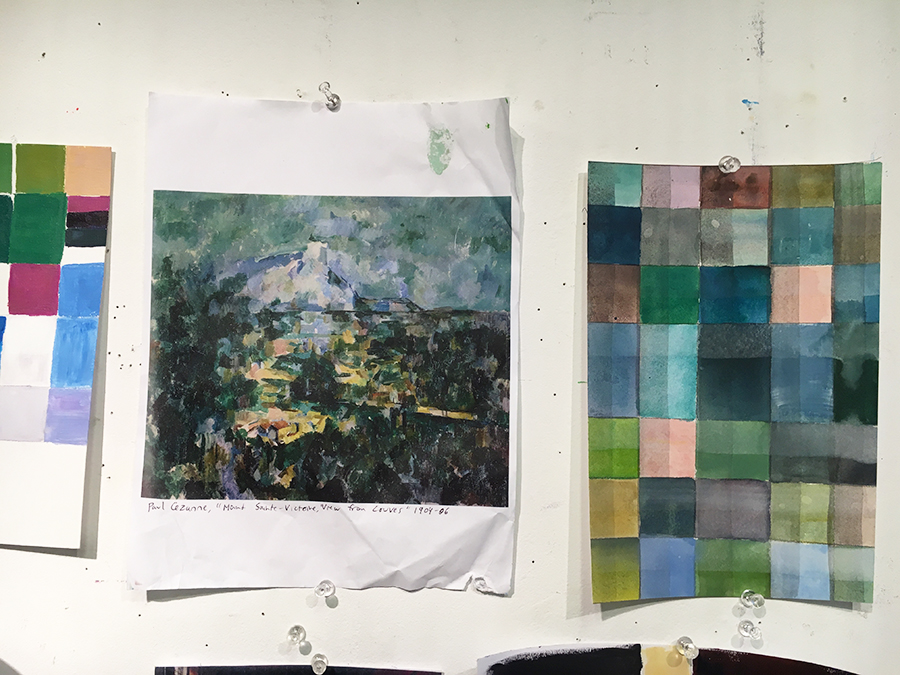
Gerald Steele's colour chart for Class 5: Green Day. He worked in watercolour and changed the format.

David Serber's colour chart for Class 5: Green Day. He worked in oil and also changed the format.
Materials FAQ
I'm unsure about this course because of the cost of the course and materials. Do we really need all these colours?
The course is 27 hours long and breaks down to about $17 an hour. The homework alone is worth the price.
I totally understand the concern about the cost of materials. I have the same experience every time I go to the art supply store! Making art in not cheap. I've taught this to nearly 100 students and I've refined the course material list to the essentials. You won't regret buying any of these colours. They will be the foundation of your colour palette from this point forward. I've selected colours that allow you to mix nearly every colour you'll encounter.
It's impossible to mix every colour using blue, red and yellow or even a six colour system. That's way too simplistic. The problems most students have is previous teachers telling them that they only need a few colours to do their paintings. This is not true and leads to a lot of frustration. That being said, you also don't need millions of colours. This list is the essentials in my opinion. I promise you that you will waste considerably less paint in the future after taking this course.
Can I leave things at your studio?
What brands of paint should I use?
I think you should always use artist quality paints from day one. One of the biggest issues students have with painting is using crappy student paints. By starting with professional paints you learn to paint once rather than having to learn twice when you end up switching. Good paint makes good paintings. For arylic I'd say Golden. For Oil I'd say Gamblin. For Watercolour I'd say Winsor and Newton.
What medium should I use?
Acrylic: Most students work in acrylic as it's easy and dries fast. But if you plan to work in another medium for your paintings then use that medium.
Oil: Working in oil is fine. You just can't use solvents in the studio. They're not necessary. Water mixable oils are also fine.
Watercolour: It's fine to use watercolour as long as you're committed to it as your medium of choice. Keep in mind that watercolour is very challenging. If you're just looking for a medium to use then I'd go with acrylic. If you intend to use watercolour then I have separate images that are watercolours to work from. Be sure to let me know if you intend to work in watercolour.
Unsure if this is for you?
Shoot me an email and we can chat about it. contact@garethbate.com
Ready? continue on to join us!
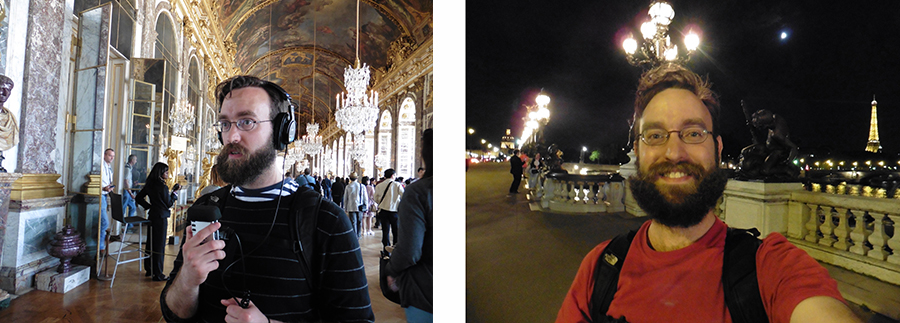
About Me
My name is Gareth Bate and I’m a full time artist, curator and art teacher living in Toronto. I work in painting, installation and photography. I have an email newsletter called "Art Untangled" where I talk about art every week. You can subscribe here. I've been asked if everything I do revolves around art and the answer is pretty much yes!
I've travelled extensively and visited all the major museums in London, Paris, New York, Washington DC, Boston, Montreal and Cape Town. I'm Festival Curator of the World of Threads Festival an international festival of contemporary fibre and textile art in Oakville. I graduated with a BFA from OCAD University and a diploma from Central Tech's adult art program. I've been teaching since 2008. I’ve been featured on CBC News and Radio Canada and in the Globe and Mail, Toronto Star, Now Magazine and La Presse among others.
Here are the courses I teach: Art World Untangled: Museum Tours
Brushstrokes and Painting Effects
The Colour Mixing Detective
Colour Stories and Relationships
Abstract & Imaginative Painting
Outdoor Abstract City Drawing Part 1, Part 2, Part 3
Art History: The Masters: 1400-1850
Art History: The Moderns: 1850-1980

Catherine Turl's colour chart for class 6: Purple Day. Catherine came up with a brilliant note taking method.
Essential Class Materials
Art Supplies are not included in the course fee.
3 large pads of heavy WHITE watercolour paper. Get ones where you can easily turn the pages rather than a block.
A variety of small flat square paint brushes.
Palette knife (at least one)
Pencil, Pen and Ruler
4 or more water containers. (clean yogurt tubs or dollar store plastic glasses)
1 medium to large flat palette of some sort. Don't buy a watercolour palette with different sections. Honestly the disposable sheet ones are great for this. There are palette's that use a sponge and can be sealed. These are great for keeping you acrylic paints wet. If you want to save money just get something in plastic like a tray.
Latex or rubber gloves. It's a good idea not to get paint on your skin.
A rag or cloth to wipe your brushes on.
1 porfolio book with sleeves. You don't need this until later. So wait to buy this.
Paint Colours:
It's crucial for all students to have EXACTLY ALL these specific colours in regular paint tubes ready for the first class. I'll send you pdfs with the pigment codes for each brand of paint. Match the pigment code that appears on the tube. You'll need access to every one of these colours each week. It might seem like a lot of colours but after teaching this course six times I've found that this colour palette allows you to mix almost every colour that appears in art history images.
I recommend you purchase artist quality brands. I believe it's important to learn to paint with artist quality brands right from the start. You should ideally stick to the same brand. Above Ground Art Supplies will give you a student discount if you show them the invoice for this course.
Hues: If the tube says "Cobalt Blue Hue" on it that means the colour is not the actual pigment. It's a cheaper alternative version. Try to find the actual one if possible.
Artist Quality Acrylics: Golden (Best), TriArt, Windsor & Newton, Liquitex. Every student eventually switches to Golden and ends up disliking the other brands. So I'd suggest buying Golden upfront and not having to replace all your paint tubes when you inevitably switch.
Artist Quality Oils: Gamblin, Grumbacher, Old Holland, Windsor & Newton.
BLUES
Ultramarine Blue, Cobalt Blue, Cerulean Blue, Phthalo Blue (Green Shade), Phthalo Blue (Red Shade), Phthalo Turquoise
REDS
Cadmium Red Light, Cadmium Red Dark, Quinacridone Magenta, Quinacridone Crimson
YELLOWS
Cadmium Yellow Light, Cadmium Yellow Dark, Benzi Yellow Light
GREEN
Phthalo Green (Yellow Shade)
WHITES & LIGHTS
Titanium White, Zinc White, Titan Buff, or Buff Titanium, Naples Yellow Hue
EARTH TONES
Raw Sienna, Yellow Ochre, Burnt Sienna, Burnt Umber, Raw Umber, Mars Black
If you are planning to work in watercolour email me for a separate colour list.
So it’s time to make a decision.
You can continue to play with MUD...
Or you can join us and learn to mix your colours properly.
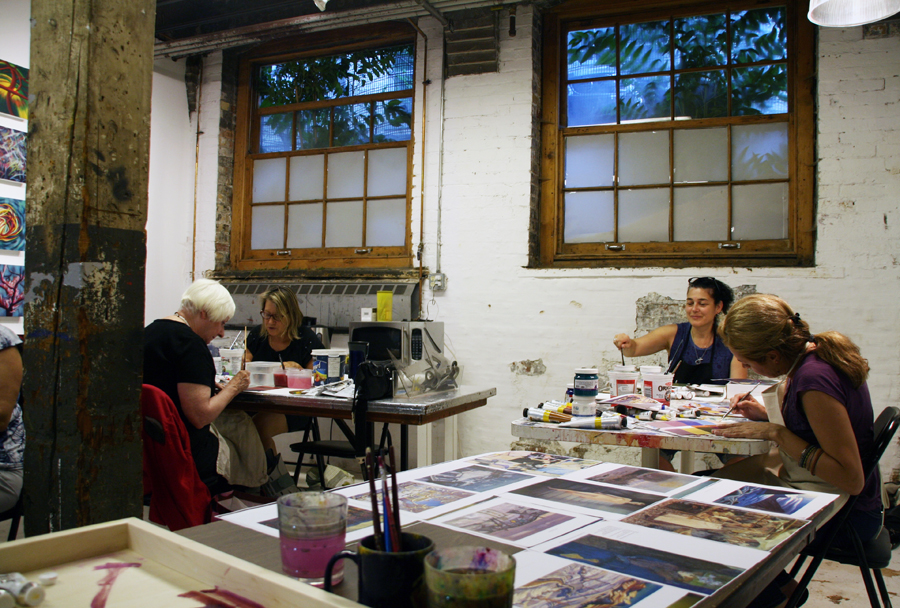
Register Now to
Reserve Your Spot!
Registration is OPEN.
COST: $449
Nine Week Course + One Free Sunday Bonus Makeup Class.
That's a 27 hour course which breaks down to around $17 an hour. Plus the free bonus makeup.
Class Material Fee: There is a $40 fee for the in class paint demonstration supplies I use and art history colour photocopies.
+HST
SPECIAL OFFER:
You can SAVE $50 off your course price if you sign up a friend who hasn't taken my courses in the past.
How to Pay
When you book I'll send you an invoice. You can then send me an online e-transfer. You could also pay by cheque mailed in advance of the course. Payment is required within two days of recieving the invoice.
Refunds Policy
I'm 100% confident in the value of this course. I therefor don't offer refunds once the course has started. This is a small class. When you sign up you're taking a spot, so it's important to commit to taking the class. I offer a lot of information on this page to help you make a decision. If you're unsure, send me an email and we can talk about it.
"I liked that you gave us honest feedback, helped us see where we had not matched colours correctly, indicated when YOU couldnt quite get the colour at first stab and mainly your supportive, warm style." - Alison Fleming
Here's how to register...
Send me an email: contact@garethbate.com
Subject Line: Registration for The Colour Mixing Detective
What to include:
Full Name
Your Email
Your Cell Phone (so I can communicate with you if necessary)
What medium do you plan to work in?
Which class are you joining? Wedneday Afternoon
Payment Policy: Payment is required on registration within 2 days of recieving your invoice.
Payment Method: Online: e-transfer or cheque.
Your Expectations: Anything in particular you're hoping to learn?
How did you hear about the course?
What happens next?
After you register I'll confirm in an email and then send you an invoice and full course info and pdfs of the art supply list.
Still Got Questions?
Send me an email: contact@garethbate.com
I'm looking forward to seeing you!
Please share my courses with anyone you know who might be interested.
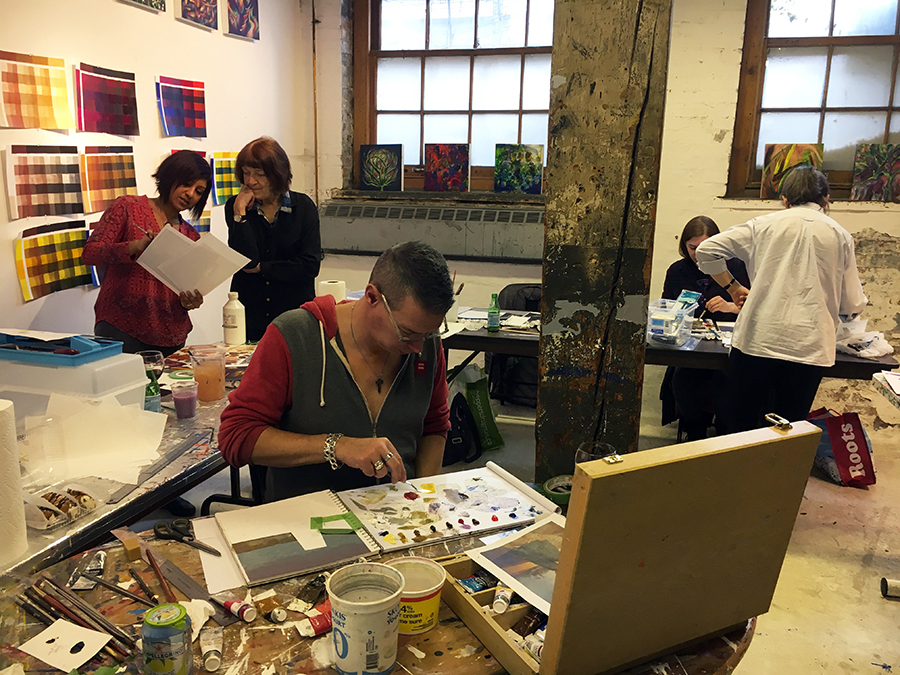
The class working away.